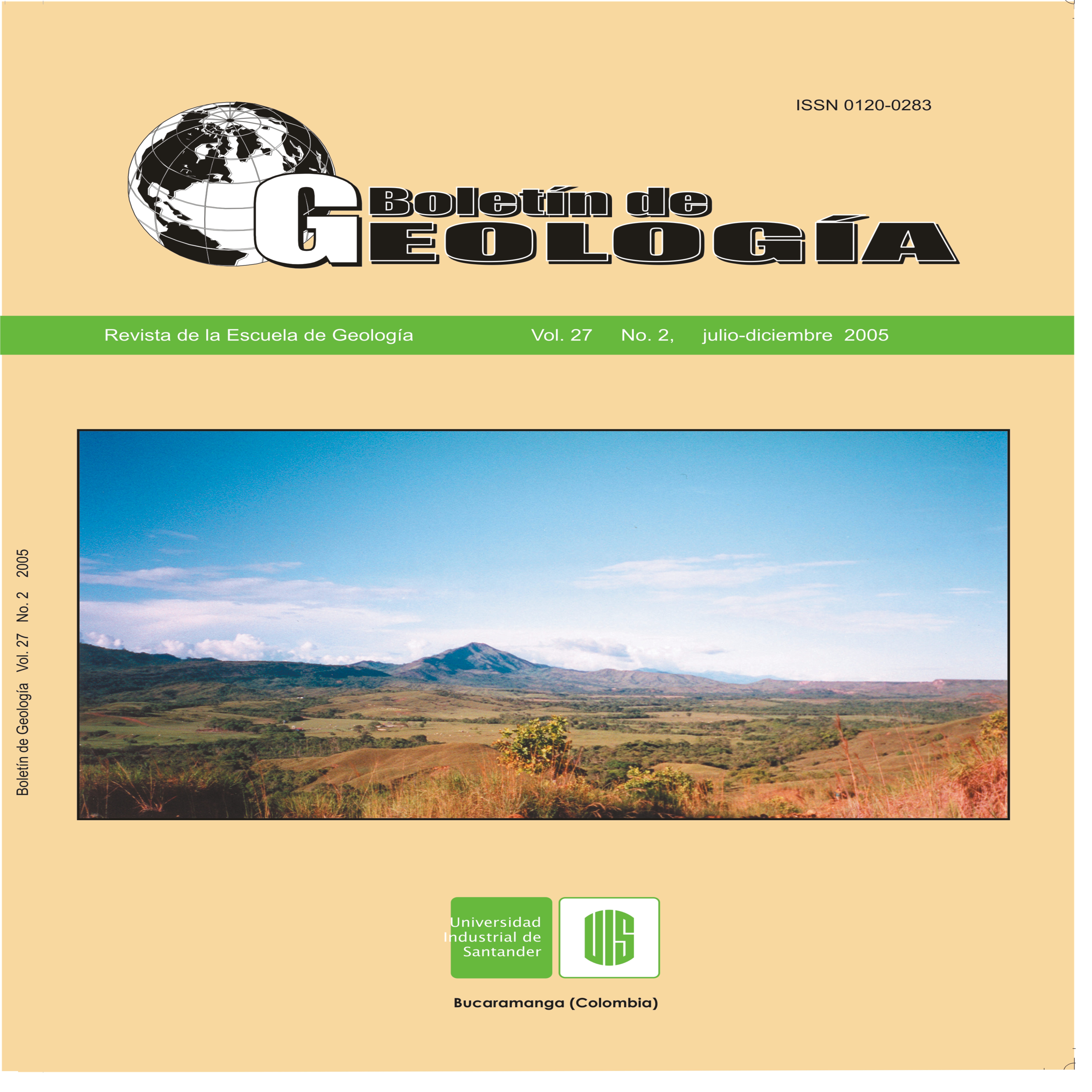APPLIED MINERALOGY TO THE DEFINITION OF THE TYPE OF REFRACTORINESS IN EL ZANCUDO GOLD MINE, ANTIOQUIA, COLOMBIA
How to Cite
Abstract
The physic and chemistry characteristics that give to the El Zancudo gold mine certain degree of refractoriness, were determined, regarding some initial bases about the problems that could occur at the moment of developing a conventional benefit system. The main metallic minerals found are arsenopyrite, pyrite and in smaller proportions sphalerite, tetrahedrite, boulangerite, galena, chalcopyrite, jamesonita, pyrrhotite and gold. Around 80% of the grains of gold are less than 30μm size, additionally, gold appears principally as small inclusions (<10μm) in pyrite (36%) and arsenopyrite (6,3%), which involve problems of liberation in the grinding process, requiring some type of pretreatment before cyanuration processes; on the other hand, the existence of silver within the gold grains (28 Wt.%), it could generate secondary silver sulfur coating and it becomes in a impermeable barrier for the cyanide. The existence of minerals like arsenopyrite and the pyrite can generate problems during the cyaniding due to the formation of different sulfur and arsenic composes which consume both oxygen and cyanide; all these factors cause that the velocity of dissolution be diminished. Finally, the sericite can generate a preg-robbing effect, diminishing the efficiency of the cyaniding process.
Key words: Refractoriness, Applied mineralogy, Gold, Sulphides, El Zancudo.
Downloads
References
Bayona, G., García, D., & Mora, G. (1994). LaFormación Saldaña: producto de la actividad deestratovolcanes continentales en un dominio de retroarco,en Etayo-Serna, F., ed., Estudios Geológicos del ValleSuperior del Magdalena: Bogotá, Universidad Nacionalde Colombia, Capítulo I, 21 p
Bayona, G., & Cortés, M. (1995). Variación facial ypetrogénesis de los depósitos de la Formación Saldañaen el sector norte del Valle Superior del Magdalena;Contribución a IGCP 322 Eventos Jurásicos en SurAmérica. Geología Colombiana, v.20, pp. 156-157
Bayona, G., Rapalini, A. E., Constanzo-Alvarez, V.,Aldana, M., Montes, C., Veloza, G., Ayala-Calvo, R.C.,Gómez-Casallas, M., & Silva, C. (2005). Rotaciones ytranslaciones de bloques definidos por paleomagnetismoen rocas del Mesozoico en Colombia, Memorias en CD -X Congreso Colombiano de Geología, Bogotá, 11 p
Butler, R. (1992). Paleomagnetism: Magnetic Domainsto Geologic Terranes. Blackwell Scientific Publications.Cambridge, 319 p
Castañeda, R. (2002). Caracterización petrográfica ygeoquímica de la Formación Saldaña en un área delmacizo Colombiano entre los departamentos de Cauca -Nariño y Putumayo [Trabajo de Grado]: UniversidadNacional de Colombia, 48 p
Castillo, J., Gose, W., & Perarnau, A. (1991).Paleomagnetic results from Mesozoic strata in the MéridaAndes, Venezuela. Journal of Geophysical Research, Vol.96, No. B4, pp. 6011-6022
Cediel, F., Mojica, J., & Macias, C. (1981). LasFormaciones Luisa, Payandé y Saldaña y sus columnasestratigráficas: Geología Norandina, v. 3, pp. 11-19
Cediel, F., & Cáceres, C. (1988). Geologic Map ofColombia, Escala 1:1200000. Geotec Ltda., Bogotá
Etayo-Serna, F., Barrero, D., Lozano, H., & otros 15autores. (1983). Mapa de terrenos geológicos deColombia, Publicación Geológica Especial: Bogotá.Ingeominas, 235 p
Fisher, R. A. (1953). Disperssion on a sphere: Proceedingsof the Royal Society of London. v. Series A217, pp.295-305
Flórez, N., & Carrillo, C. (1994). Estratigrafía de lasucesión litológica basal del Cretácico del Valle Superiordel Magdalena, en Etayo-Serna, F., ed., EstudiosGeológicos del Valle Superior del Magdalena: Bogotá,Universidad Nacional de Colombia, Capítulo II, 26 p
Gose, W. A., Perarnau, A., & Castillo, J. (2003).Paleomagnetic results from the Perijá Mountains,Venezuela: an example of vertical axis rotation. In:Bartolini, C., Buke, K., Blickwede, J., and Burkart, B.,eds, The Gulf of Mexico and Caribbean region:Hydrocarbon habitats, basin formation and platetectonics. AAPG memoir 79. pp. 969-975
Kirschvink, J.L. (1980). The least-squares line and planeand the analysis of palaeomagnetic data. GeophysicalJournal of the Royal Astronomy Society., v. 62, pp. 699-718.
Lowrie, W. (1990). Identification of ferromagneticminerals in a rock by coercivity and unblockingtemperature properties: Geophysical Research Letters,v. 17, pp. 159-162
MacDonald, W. D., & Opdyke, N. D. (1984). Preliminarypaleomagnetic results from the Jurassic rocks of the SantaMarta Massif, Colombia, in Shagam, R., ed., TheCaribbean-South American plate boundary y regionaltectonics. Geological Society of America Memoir 162,pp. 295-298.
McFadden, P. L., & McElhinny, M. W. (1990).Classification of the Reversal Test in Paleomagnetism.Geophysics Journal International, v. 103, pp. 725-729
Mojica, J., & Llinás, R. D. (1984). Observacionesrecientes sobre las características del basamentoeconómico del Valle Superior del Magdalena en la regiónde Prado-Rovira (Tolima, Colombia) y en especial sobrela estratigrafía y petrografía del Miembro Chicalá (=partebaja de la Formación Saldaña). Geología Colombiana, v.13, pp. 81-128
Mojica, J., Macías, C., & Colmenares, F. (1985).Consideraciones sobre la importancia de la paleogeografíay las áreas de aporte pre-Cretácicas en la prospecciónde hidrocarburos en el Valle superior del Magdalena,Colombia. Geología Colombiana, v. 14, pp. 49-70
Mojica, J., & Prinz-Grimm, P. (2000). Las faunas deAmonitas del Triásico Tardío en el Miembro Chicalá(=parte baja de la Formación Saldaña) en Payandé,Tolima, Colombia. Geología Colombiana, v. 25, pp. 13-23.
